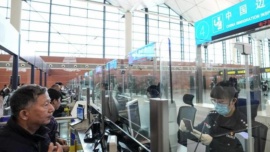In South Africa’s Western Cape Province, a large herd of the bontebok, an antelope subspecies originating from Damaliscus pygargus species, roam freely within a namesake national park. The large white blaze on their face distinguishes them from other animals in the park.
“At the moment the bontebok population (in Bontebok National Park) is quite healthy, and it is growing steadily,” Bontebok National Park manager Bulelwa Msengi told Xinhua in a recent interview.
The last count done two weeks ago showed that the national Park has 194 bontebok, including 14 calves in its 3,400-hectare fully fenced area, but the number could increase as they are in the lambing season, which is from September to October or early November sometimes, and are still giving birth, said Msengi.
As early as 1931, the original site of Bontebok National Park was near Western Cape’s Bredasdorp to conserve the last remaining 17 bontebok, said Msengi. Although bontebok numbers increased to around 100, population growth thereafter halted as the habitat of the park was found to be unsuitable for this species, and in 1940s some bontebok were sent to another place to establish a backup population.
The manager said that later in 1961, the park was moved to its current location in Swellendam, where there is the indigenous vegetation known as fynbos, to provide the bontebok a more suitable and bigger place to thrive. By 1969, it was estimated that the population of the bontebok in the park had been restored to around 800.
Their numbers have increased to 3,000 at present, making the conservation story a “heart-warming success,” according to South African National Parks (SANParks), the national parks management body.
The conservation began earlier than the official intervention, when some land owners set aside portions of their properties to form temporary reserves, said the SANParks.
To ensure the grazers have enough food and avoid too much competition in this regard, the park usually keeps the number of them between 130 to 180, within the range that the park can afford based on its capacity, said Msengi, adding that the park will start to discuss with SANParks’ game capture unit to translocate some bontebok to other parks or reserves after another count early next year.
In the history, private farmers moved bontebok out of their natural distribution range to other areas of the country, where the blesbok, another subspecies of the Damaliscus pygargus species, lived, mainly for hunting and breeding, hence hybridization through human-influenced interbreeding on the private ranches.
The bontebok are adapted to the renosterveld bioregion within Western Cape, the only natural distribution area for the bontebok, while the blesbok roam widely on the grasslands of Gauteng, Eastern Cape, Mpumalanga and Free State provinces. The blesbok is currently listed as the Least Concern by the International Union for Conservation of Nature (IUCN) Red List of Threatened Species, while the bontebok, after its population increases, is listed as Vulnerable, a category better than Endangered.
Hybridization used to be a big problem and it will cause the loss of genetic integrity of the two subspecies, SANParks regional ecologist Marna Herbst warned in a telephone interview with Xinhua.
A national biodiversity management plan for the bontebok was published in 2019 by the government to ensure the long-term survival of the bontebok in the nature with objectives including conserving the genetic integrity and diversity of the bontebok, preventing further habitat loss and habitat degradation, establishing and maintaining effective communication and awareness between and among stakeholders, and investigating and conducting research aimed at supporting adaptive management and the implementation of actions to promote and ensure bontebok conservation.
The plan seeks to bring together the private sector, national and provincial agencies, government departments and others to take concerted actions. For instance, it guides the stakeholders to codevelop an exit policy for the removal of blesbok and hybrids within the natural distribution range and develop standardized population monitoring protocols for bontebok populations on the private land.
“It’s really a big collaboration between national agencies, provincial agencies, nature reserves, farmers and other stakeholders. Creating these partnerships and working together we established a metapopulation, a species-specific management plan for bontebok on a national level,” said Herbst.
With registration, now the private farmers are not allowed to have both bontebok and blesbok on the same property outside the natural distribution range, and in the original bontebok distribution range, they are not allowed to bring in blesbok, said Herbst, adding that the stakeholders are trying to keep track of where bontebok is going and to get a national idea of what is going on.
“If it is one group or one person or just the government, it won’t succeed. It really needs partnership across the agencies and the hard work,” she added.
Herbst is a member of SANParks Scientific Services unit, which works closely with the park. She works at the interface between science and management and is responsible for coordinating, conducting and reporting on aerial surveys of the wildlife species and wildlife management recommendations in national parks including Bontebok.
Besides SANParks’ own scientists, Bontebok National Park also works with other scientists to do researches in the park. Scientists will inform the management including the status of the grazing lands based on their research and the management will make decisions based on it, according to Msengi.
Msengi said due to measures like patrolling every day, the park hasn’t experienced poaching of the bontebok. And she has kept the patrolling time secret to ensure the park’s security.
Despite the increased number of the bontebok population, Herbst said they still face a “big threat” of reduction and degradation of habitat, adding that their habitat is restricted to renosterveld vegetation type, which is at the moment critically endangered.
As Bontebok National Park, surrounded by agriculture developments and a town, is a small park and can’t even extend, it only has a small population that could lead to inbreeding, so bontebok individuals have to be moved over time from one park to another reserve, from one farm to another farm, to avoid inbreeding.
by Xinhua writer Lyu Tianran





















